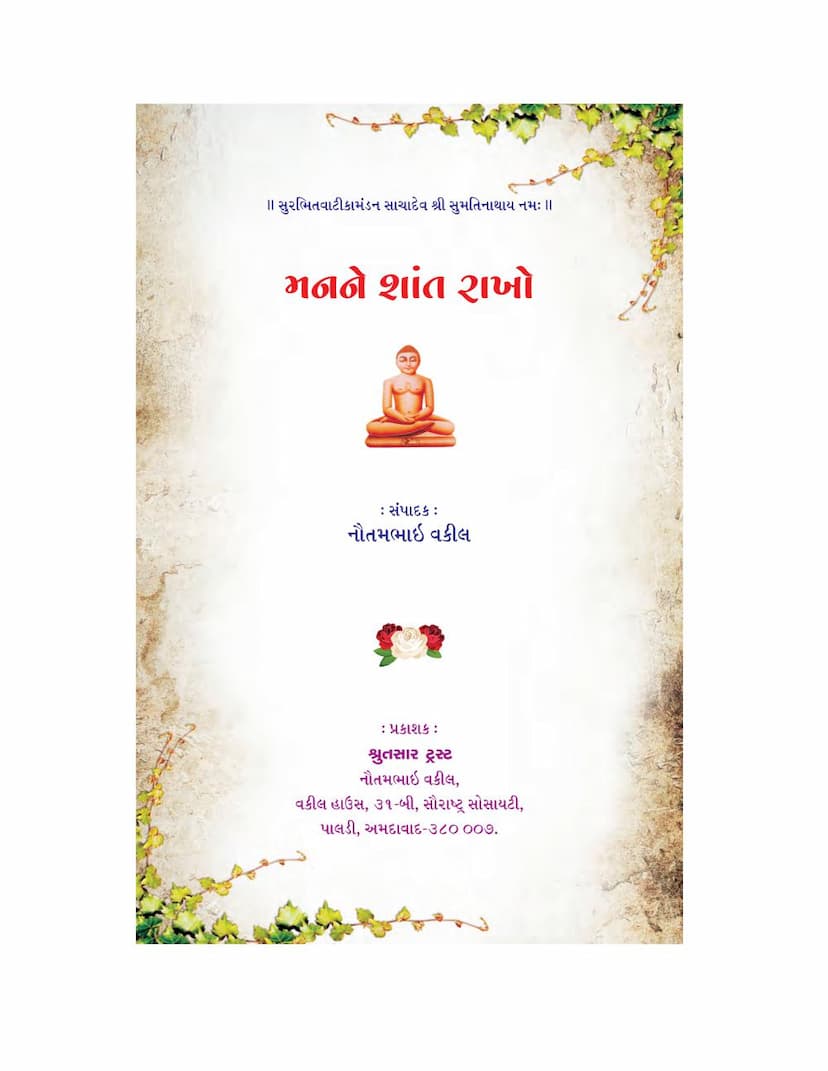Manne Shant Rakho
Added to library: September 2, 2025

Summary
Here's a comprehensive summary of the Jain text "Manne Shant Rakho" by Nautambhai R. Vakil, based on the provided pages:
Title: Manne Shant Rakho (Keep Your Mind Peaceful)
Author: Nautambhai R. Vakil
Publisher: Shrutsar Trust
Overview: "Manne Shant Rakho" is a Jain text authored by Nautambhai R. Vakil, published by Shrutsar Trust. The book aims to guide readers towards achieving mental peace by understanding and controlling the mind, particularly by mitigating the impact of the four primary passions (Kashayas): Anger (Krodh), Ego (Maan), Deceit (Maya), and Greed (Lobh). The book emphasizes that true spiritual well-being and liberation are achieved by taming the mind and overcoming these internal afflictions, rather than solely through external religious practices.
Key Themes and Content:
-
The Importance of a Peaceful Mind: The book begins by highlighting the agitated state of people in the current era and presents the spiritual writings as a means to find peace. It stresses that the mind is the cause of both bondage and liberation (moksha).
-
The Four Kashayas (Passions): The core of the book delves into the detrimental effects of the four Kashayas, which are presented as the root cause of suffering and impure thoughts (dhyana).
- Krodh (Anger): Explained as a waste of energy and a cause of disharmony. It's linked to expectations and the inability to see one's own faults. Various examples illustrate how anger leads to negative consequences, even affecting physical health. The book suggests overcoming anger by reducing expectations, focusing on self-improvement, and remembering the principles of karma.
- Maan (Ego/Pride): Presented as the root of many vices, leading individuals away from humility and virtue. It manifests in various forms like pride in lineage, wealth, knowledge, or austerity. The text emphasizes that ego blinds individuals and hinders spiritual progress. Overcoming ego is linked to cultivating humility, seeking guidance from true gurus, and recognizing the impermanence of worldly achievements.
- Maya (Deceit/Illusion): Described as a subtle yet destructive force that hides faults and fosters falsehoods. It's the mother of untruth and can lead to negative karma and rebirths. The book advocates for simplicity and truthfulness as antidotes to Maya, illustrating its detrimental effects through stories and examples.
- Lobh (Greed/Attachment): Identified as the "father of sins" that leads to insatiable desires, dependency, and unhappiness. It affects individuals from the smallest creatures to the most powerful beings, even infiltrating religious practices. The book stresses the importance of contentment and renouncing excessive desires to find true peace and spiritual progress.
-
The Nature of Dhyana (Meditation/Thought): The book categorizes thoughts into different types of Dhyana:
- Art-Dhyana (Mournful Thought): Arising from desires and attachments.
- Raudra-Dhyana (Cruel/Fierce Thought): Stemming from anger, hatred, and violence.
- Dharma-Dhyana (Virtuous Thought): Associated with righteous actions and devotion.
- Shukla-Dhyana (Pure Thought): The highest form of meditation, leading to liberation. The book extensively discusses how the Kashayas lead to Art and Raudra Dhyana, which are considered impediments to spiritual advancement. It advocates for cultivating Dharma and Shukla Dhyana through mindful awareness and self-control.
-
Practical Guidance and Examples: The text offers practical advice and uses numerous anecdotes from Jain scriptures and everyday life to illustrate the concepts. It draws from works like "Aaturpratyakhyan," "Zanu," and the teachings of revered Acharyas. The author also shares personal experiences, including his lectures in America and the construction of a temple.
-
The Role of Knowledge and Practice: The book emphasizes that mere knowledge is insufficient; it must be coupled with diligent practice and a shift in one's inner attitude. It stresses the importance of introspection, self-awareness, and striving for inner purification.
-
The Significance of Simplicity and Contentment: Throughout the text, the virtues of simplicity, contentment, and detachment are highlighted as crucial for overcoming Kashayas and achieving mental tranquility.
-
Devotion and Spiritual Aspiration: The author expresses gratitude to his parents, gurus, and patrons, underscoring the importance of spiritual lineage and the support of the community in one's spiritual journey. The ultimate goal is presented as achieving spiritual well-being and liberation.
Key Takeaways:
- Mind Control is Paramount: The primary message is that controlling the mind is the key to overcoming suffering and achieving spiritual growth.
- Kashayas are Obstacles: Anger, ego, deceit, and greed are identified as major hindrances to peace and liberation.
- Inner Transformation is Essential: True religious practice involves transforming one's inner state rather than just performing external rituals.
- Simplicity and Contentment Lead to Peace: Embracing a simple lifestyle and cultivating contentment are vital for mental peace.
- Awareness and Vigilance: Constant awareness of one's thoughts and intentions is necessary to prevent negative thoughts and emotions from taking root.
- Spiritual Wisdom from Scriptures: The book draws heavily on Jain scriptures and the wisdom of great saints to provide guidance.
In essence, "Manne Shant Rakho" is a practical guide for Jain followers, and indeed for anyone seeking inner peace, by delving into the psychological and spiritual aspects of managing one's mind and overcoming the destructive forces of the Kashayas.